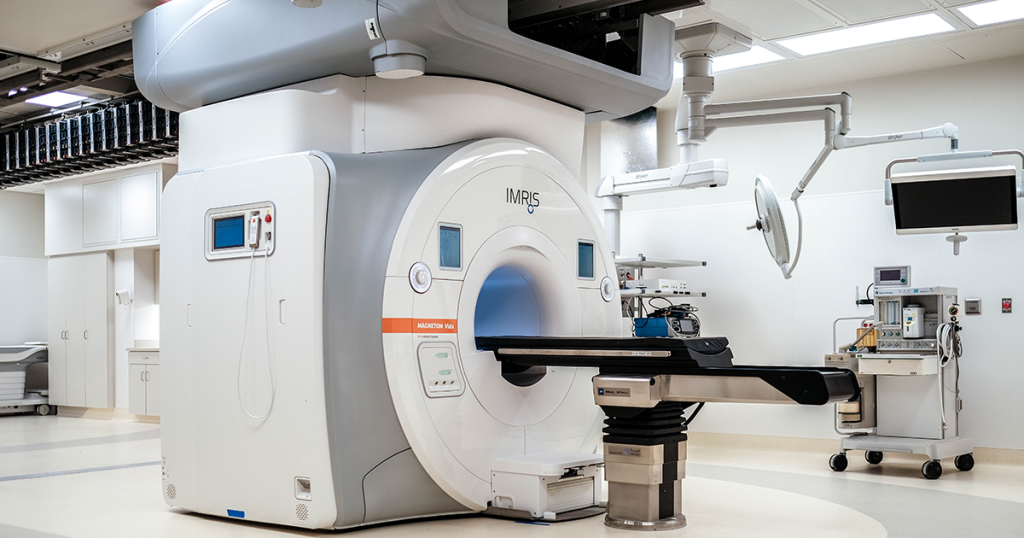When Peter’s ophthalmologist noticed subtle eye movement abnormalities during his eye exam, the 14-year-old was referred to Children’s Minnesota for an MRI. The scans revealed a dermoid cyst, a large, slow growing, non-cancerous brain tumor that filled Peter’s ventricles, wrapped around his critical brain structures including the thalamus and fornix, and extended into his brainstem. The dermoid cyst likely started forming when Peter was a fetus.
The MRI also detected Peter had hydrocephalus. The large tumor acted like a dam and created a buildup of cerebrospinal fluid (CSF) in his brain. Even without surgery or treatment of the tumor, the hydrocephalus would require surgery to place a shunt from Peter’s brain to his abdomen to drain the CSF. Peter was immediately admitted to Children’s Minnesota’s Minneapolis hospital for observation and eventual brain surgery.
Complex procedure with successful outcome
Pediatric neurosurgeon Amy Bruzek, MD, led the team from the Children’s Minnesota neurosurgery program that cared for Peter. The complexity of Peter’s brain surgery was explained by Dr. Bruzek and her team to Peter and his family prior to the procedure. The tumor was so intertwined around critical brain structures and large blood vessels, if they were damaged during surgery, it could be instantly life-threatening. Additionally, removing the full tumor could impact memory or other cognitive abilities, or cause permanent weakness or numbness on one side of Peter’s body.

In September 2023, just 11 days after Peter first learned about his tumor, Dr. Bruzek and her team performed a 12-hour craniotomy procedure. Dr. Bruzek removed a small portion of Peter’s skull to create a temporary opening and then inserted an endoscope to see the tumor and surrounding brain tissue in his skull. She was able to remove at least 85% of the tumor. Dr. Bruzek was also able to correct Peter’s hydrocephalus without placing a shunt since the fluid buildup stopped on its own once most of the tumor was gone and alternative routes were created for the fluid to flow.
“Doing this endoscopic procedure for such a large tumor was a big plus for Peter,” Dr. Bruzek said. “It can reduce the risk of post-surgery challenges, leaves a smaller incision and can help speed up recovery. I feel honored to be part of Peter’s care team.” Dr. Bruzek has trained with some of the world’s leading neurosurgeons on various highly specialized techniques. She joined Children’s Minnesota in August 2023.
Real-time MRI scans with state-of-the-art neurosurgery technology
Children’s Minnesota is home to North America’s first pediatric hybrid intraoperative magnetic resonance imaging (iMRI) suite equipped with both moving-scanner and moving-patient MRI technology in the same surgical space. This state-of-the-art neurosurgery technology allows care teams to make enhanced clinical decisions using mid-procedure MRI scans directly at the point of care to improve patient outcomes.

During Peter’s procedure, the neurosurgery and radiology teams were able to seamlessly move the 16,200-pound MRI scanner directly into the operating room via a ceiling-mounted rail system while the high-powered 3T scanner took crystal-clear images. Dr. Bruzek and her team were able to confirm in real time when the parts of Peter’s tumor were safely removed so the whole procedure was done in a single surgery.
Whole patient care – including the family
Peter recovered from his surgery in the pediatric intensive care unit (PICU) and general surgery floor. His care team also included physical and occupational therapists and child life specialists.
“The staff all cared for me and about me personally,” Peter shared. “They were willing to do whatever they could to be encouraging, supportive and help [me] get better as quickly as possible.” Peter’s mom Melissa added, “One of the many things that really impressed me about Children’s Minnesota, besides exceptional medical care, is how thoroughly [they] care for the whole patient and even the family.”
Peter has regular appointments with his neurosurgery team, and he has also returned to high school. It is likely that what’s left of his dermoid cyst will continue to slowly grow, so it will be monitored throughout his life and another surgery is possible in the future.
About Children’s Minnesota’s neuroscience program
The neuroscience program at Children’s Minnesota provides care for more pediatric neurology, brain tumor, and epilepsy patients than any other hospital in the region, performing more than 500 neurosurgeries each year. For a consultation or to refer a patient, call Children’s Minnesota Physician Access at 866-755-2121.
Doctors and healthcare providers call for 24/7 patient referral, admission and neonatal transport assistance. Learn more.